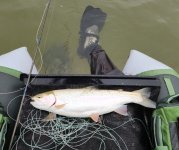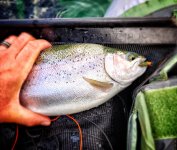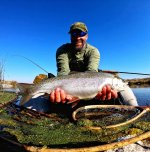Many of the fish in EWa taste like mud. Why would anyone want to eat them?
Make those lakes C&R quality fisheries?
I say let people continue to eat mud and thin the herd for those that want to practice c&r if they want….
SF
Many of the fish in EWa taste like mud. Why would anyone want to eat them?
Make those lakes C&R quality fisheries?
It’s part of their job to get rid of detrimental species.For anyone who is interested in learning more about the how’s and why’s of managing our trout lakes, I’d suggest contacting your regional WDFW biologist. But probably don’t start by informing them that they don’t care about “serious anglers”
BC lakes typically don’t have spiny ray species, for starters.
In a series of lakes where trout have been introduced and aren't native to the waters.I am being serious, I would like to know where in the Washington Administrative Code and Revised Code of Washington it specifies that WDFW is responsible for removal of deleterious species.
I agree with troutpocket, contact your WDFW regional biologist and ask them about the history of management at Lenice. Also ask them about the cost of eliminating sediment transport and ability of spiny rays to access Lenice.
I am being serious, I would like to know where in the Washington Administrative Code and Revised Code of Washington it specifies that WDFW is responsible for removal of deleterious species.
You are correct, rotenone cannot rid lakes of sunfish which find refuge in vegetatation.I'm curious about how effective rotenone treatment is at removing unwanted species - it seems to me that with lakes that have lots of shallows that support dense tule, cattail, phragmite and other plant growth that getting the toxin into the vegetation where undoubtedly some of the fish reside, would be next to impossible.
And then there's the health risk (perceived, factual? I don't know.) from the chemical - I've read here on the internet, and we all know everything published here is factual, that rotenone can be a trigger to Parkinson's. The last "Blue" (Sun Lakes chain) was treated, there was quite an uproar from lakeside residents.
Just google “WDFW rotenone lakes”. They state themselves that they use it to control fish populations
Which makes sense. They’re responsible for managing the fishery and unwanted species get in the way of management.
Also, the history of management, while interesting, ultimately doesn’t change the fact that I’ve watched the quality of fish go down with my own two eyes.
Willful ignorance in the face of overwhelming evidence is always an interesting thing to me. But don’t let me get in the way of your, “My own two eyes.” argument.
Smart manUnless you let the browns and tigers eat the sunny's....
But we digress....
Fishing was always better in the good ole days. Always. I remember my dad taking me to spots where the trout were as long as my arm and a full stringer was too heavy to pick up. And we had the whole place to ourselves.Just google “WDFW rotenone lakes”. They state themselves that they use it to control fish populations
Which makes sense. They’re responsible for managing the fishery and unwanted species get in the way of management.
Also, the history of management, while interesting, ultimately doesn’t change the fact that I’ve watched the quality of fish go down with my own two eyes.
Is this a quality fish?No need to be an ass.
Give me the "overwhelming evidence". I haven't seen squat.
 How about this one?
How about this one?  Or maybe this one?
Or maybe this one?  There are still big fish out there. Lakes change over time. I can think of numerous lakes that have had undesirable fish within a few years after rehabilitation. Some of these lakes had tremendous fishing for a few years yes. But if a rehab isn't going to last more then 5 years what is the point? Examples include the Hampton Lakes, Teal Lakes, Park and Blue and so on.
There are still big fish out there. Lakes change over time. I can think of numerous lakes that have had undesirable fish within a few years after rehabilitation. Some of these lakes had tremendous fishing for a few years yes. But if a rehab isn't going to last more then 5 years what is the point? Examples include the Hampton Lakes, Teal Lakes, Park and Blue and so on. On the surface yes good idea. We all miss them in those lakes. The reality is I don't think it would work anymore even after a rehab. It just seems they don't compete that well or do that well overall. Look at Beda for example. They can't even survive in a lake alone. A couple years after a rehab.Unless you let the browns and tigers eat the sunny's....
But we digress....
Are Canadians less prone to bucket biology and/or accidental introductions than Americans? Is there something inherent to BC lakes that makes them less prone to spiny ray infestations? Something else?For anyone who is interested in learning more about the how’s and why’s of managing our trout lakes, I’d suggest contacting your regional WDFW biologist. But probably don’t start by informing them that they don’t care about “serious anglers”
BC lakes typically don’t have spiny ray species, for starters.
From what I understand, BC residents value their trout fisheries very highly. I’m not aware of many spinyrays in the provence outside of the lower mainland. So without more to go on, I think it’s a cultural thing.Are Canadians less prone to bucket biology and/or accidental introductions than Americans? Is there something inherent to BC lakes that makes them less prone to spiny ray infestations? Something else?
Sheridan? I suppose someone dumping their goldfish bowl into a lake isn't the same as bucket biologists introducing smallmouth back into Park or Blue right after a rehab. Something else that occurs to me - completely off topic - is water clarity. So many of the lakes I drive past on my way towards Kamloops have such clear water, enticing shoals. I love the drive between Princeton and highway 97 west of Merritt - seeing those clear lakes gets me jazzed for the upcoming adventure (leaving May 28th).From what I understand, BC residents value their trout fisheries very highly. I’m not aware of many spinyrays in the provence outside of the lower mainland. So without more to go on, I think it’s a cultural thing.
No need to be an ass.
Give me the "overwhelming evidence". I haven't seen squat.
Those are damn nice fish. Did you catch em in Lenice?Is this a quality fish? View attachment 61742How about this one? View attachment 61743Or maybe this one? View attachment 61744There are still big fish out there. Lakes change over time. I can think of numerous lakes that have had undesirable fish within a few years after rehabilitation. Some of these lakes had tremendous fishing for a few years yes. But if a rehab isn't going to last more then 5 years what is the point? Examples include the Hampton Lakes, Teal Lakes, Park and Blue and so on.
And the truth is if I lived on a lake I wouldn't want that lake treated either so I agree with the homeowners in that sense. There are probably plenty of undesirable aspects of treatment. And again with treatments not lasting long. What's the point?
I think we have a pretty nice plethora of options in our area all things considered. We all cling to the good old days. I too had fond memories of Lenice. But there are quality fish and lakes to be found still.
On the surface yes good idea. We all miss them in those lakes. The reality is I don't think it would work anymore even after a rehab. It just seems they don't compete that well or do that well overall. Look at Beda for example. They can't even survive in a lake alone. A couple years after a rehab.